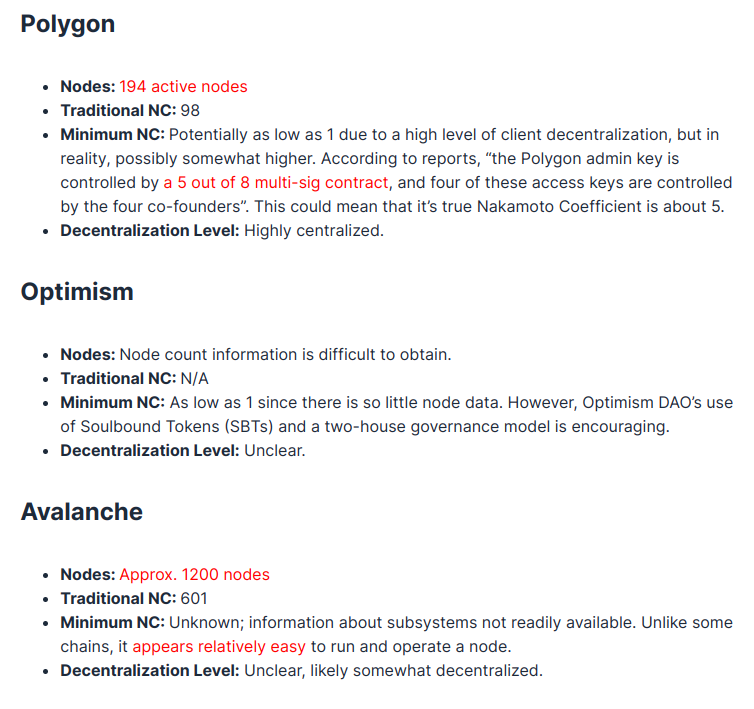Measures of decentralization play a crucial role in understanding and assessing the distribution of power and resources within various systems, such as Decentralized Autonomous Organizations (DAOs), blockchain networks, and economic structures. In this article, we have explained three indices that have been used to measure decentralization.
Gini Coefficient
The Gini coefficient, or Gini index, is a measure traditionally used in economics to quantify income or wealth distribution within a population. It can also be applied to assess decentralization in various contexts, including in DAOs (Decentralized Autonomous Organizations). In short, The Gini coefficient is a prominent metric, quantifying the inequality in the distribution of assets or influence; a lower Gini index indicates a more equal distribution, hence greater decentralization.
The Gini coefficient ranges from 0 to 1, where 0 represents perfect equality (everyone has the same wealth or resources) and 1 represents perfect inequality (all wealth or resources are concentrated in the hands of a single individual). It is calculated based on the Lorenz curve, which plots the cumulative share of wealth against the cumulative share of the population. A high Gini coefficient in a DAO would imply that a large portion of voting power or tokens is concentrated in the hands of a few members, indicating a high degree of centralization.
Considerations
Dynamic Nature: The Gini coefficient should be viewed as a snapshot in time. DAOs are dynamic entities, and the distribution of tokens or power can change, so regular assessments are beneficial.
Complementary Measures: It’s often used alongside other measures like entropy or the Nakamoto coefficient for a more comprehensive view of decentralization. We will talk about these measures in the next section.
Nakamoto Coefficient
The Nakamoto Coefficient is a measure used to assess the level of decentralization in blockchain systems, particularly in the context of governance and decision-making. It was named after Satoshi Nakamoto, the pseudonymous creator of Bitcoin. This metric focuses on identifying the minimum number of entities (such as nodes, miners, or stakeholders) required to collude or cooperate in order to control a majority of the system’s resources or decision-making power.
The Nakamoto Coefficient identifies the smallest number of entities needed to achieve more than 50% control of a given resource, like hashing power in a blockchain, stake in proof-of-stake systems, or voting rights in a governance context. To calculate it, entities are ranked by the size of their contribution (e.g., hashing power, stake, voting rights) and added up in order until the cumulative total exceeds 50% of the total system’s resources or power. The number of entities required to reach this threshold is the Nakamoto Coefficient.
Application in Governance
In governance systems, such as DAOs, the Nakamoto Coefficient can be applied to voting power. It quantifies how many of the largest voting members would need to collaborate to unilaterally make decisions or pass proposals. A higher Nakamoto Coefficient indicates greater decentralization, as it means a larger number of entities are required to control governance.
The Nakamoto Coefficient, though not a flawless metric, provides significant insights into the actual decentralization levels of various blockchains, including major ones like Bitcoin and Ethereum. Below, the Nakamoto Coefficient (NC) for several layer2 networks has been calculated by SUPRA. It’s evident that some well-known L2 platforms are either highly centralized, or there’s a lack of conclusive evidence supporting a significant decentralization factor.

Adopting this coefficient as a standard industry measure could drive blockchain projects towards greater decentralization. Ultimately, widespread use of the Nakamoto Coefficient could play a crucial role in mitigating regulatory pressures, boosting cryptocurrency values, and fostering growth in the blockchain sector.
Entropy
Entropy is an interesting concept that ranges from Thermodynamics to Information Theory. Entropy is a measure that can be used to quantify the degree of decentralization in various systems, including governance structures like Decentralized Autonomous Organizations (DAOs) or blockchain networks. It provides a statistical measure of randomness or unpredictability, which, when applied to governance, can indicate how dispersed or concentrated control and decision-making power are within the system. Entropy quantifies the unpredictability or randomness of a system. In simple terms, it measures how much information is produced by a process or how much uncertainty there is in a system.
Application in Governance
In a governance context, entropy can be calculated based on the distribution of voting power, token ownership, or other measures of influence. The formula typically involves calculating the probability distribution of these measures and then applying the Shannon entropy formula.
High entropy in a governance system suggests that decision-making power is distributed widely among many participants, reducing the likelihood of control by a small group. Conversely, low entropy indicates that power is concentrated, signaling centralization.
Considerations
Not a Standalone Measure: While entropy is a valuable metric, it should not be the only measure used to assess decentralization. It’s best used in conjunction with other metrics like the Gini coefficient or Nakamoto coefficient.
Complexity and Interpretation: Calculating and interpreting entropy requires a certain level of statistical and mathematical understanding. It might not provide an intuitive sense of the system’s structure to those unfamiliar with these concepts.
Voting-Bloc Entropy (VBE)
Voting-Bloc Entropy (VBE) is a relatively new measure proposed to assess decentralization, specifically in the context of Decentralized Autonomous Organizations (DAOs) and their governance structures. It represents a more nuanced approach to understanding decentralization, focusing on the diversity and alignment of participants’ interests and voting behaviors.
VBE is based on the concept of utility functions of DAO participants. A utility function, quantifies the gain or loss a participant perceives from various voting outcomes. In VBE, a voting bloc is defined as a group of participants whose utility functions are similar across a range of decisions or proposals. The size and number of such blocs are indicative of the level of centralization or decentralization in the DAO.
Calculation and Interpretation
VBE measures the entropy over the voting blocs. Entropy, in this context, is used to assess how concentrated or dispersed these blocs are. A higher entropy suggests a more diverse range of utility functions and, consequently, a higher level of decentralization. It is important to note that VBE is a theoretical metric. Direct measurement is challenging because utility functions are often latent variables – they’re conceptually important but not always directly observable.
VBE provides a framework to evaluate the decentralization of governance within DAOs. By analyzing the distribution and diversity of voting blocs, VBE can indicate whether decision-making power is concentrated among a few aligned groups or dispersed across a wide range of independent participants. Insights derived from VBE can guide the design and modification of governance protocols in DAOs. For instance, if VBE suggests a high level of centralization, mechanisms to encourage broader participation and diverse representation in decision-making might be implemented.
Advantages and limitations of VBE
+ Beyond Token Distribution: Unlike measures that focus solely on token ownership or voting rights distribution, VBE takes into account the actual preferences and behaviors of participants, providing a more holistic view of decentralization.
+ Nuanced Understanding: VBE allows for a more nuanced understanding of decentralization, capturing complex dynamics like the formation of voting blocs, the influence of influential participants, and the subtleties of collective decision-making.
– Complexity and Implementation: The theoretical nature of VBE makes it complex to implement and understand. It requires sophisticated methods to approximate utility functions and analyze voting patterns.
– Dynamic Environment: As with other measures, VBE may need regular reassessment due to the dynamic nature of DAOs and the evolving preferences and behaviors of participants.
Conclusion
In conclusion, the exploration of decentralization measures such as the Gini Coefficient, Nakamoto Coefficient, Entropy, and Voting-Bloc Entropy (VBE) provides a comprehensive toolkit for assessing and understanding the distribution of power and resources in various systems, including DAOs and blockchain networks. Each of these measures offers unique insights into the structure and dynamics of governance, revealing different facets of decentralization.
References
- “Open Problems in DAOs” arXiv. Link
- “Gini coefficient” Wikipedia. Link
- “DAO Decentralization: Voting-Bloc Entropy, Bribery, and Dark DAOs” arXiv. Link
- “Using The Nakamoto Coefficient To Measure Blockchain Decentralization” SUPRA. Link
- “The Most Misunderstood Concept in Physics” YouTube. Link
- “Information entropy | Journey into information theory, Khan Academy” YouTube. Link



